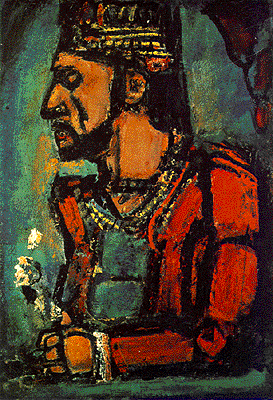 *
* *
*The Carnegie Museum of Art, founded in 1895 by Andrew Carnegie, is one of the organizations that comprise Carnegie Institute. Today these include The Carnegie Museum of Art and The Andy Warhol Museum as well as The Carnegie Museum of Natural History and The Carnegie Science Center. The Carnegie Museum of Art serves a Pittsburgh-area audience of 2.2 million people as well as visitors from eastern Ohio, northern West Virginia, and western Pennsylvania. During the past ten years, the museum's audience has also become increasingly international, in part, because of the tradition and reputation of the Carnegie International exhibition, one of the most important forums in the world today for the presentation of contemporary art.
While most art museums founded at the turn of the century focused on collections of old masters, Andrew Carnegie envisioned a museum collection consisting of "the old masters of tomorrow." In 1896 he initiated a series of exhibitions of contemporary art and proposed that the museum's paintings collection be formed through purchases from this series. Carnegie, thereby, founded what is arguably the first museum of modern art in the United States. Early acquisitions of works by such artists as Winslow Homer, James McNeill Whistler, and Camille Pissarro laid the foundation for a collection that today is distinguished in American art from the mid-19th century to the present, in French Impressionist and Post-Impressionist paintings, and in significant late 20th-century works.
Over the century the museum has amplified its scope of interest to include European and American decorative arts from the late 17th century to the present. Architect-designed objects figure prominently among recent acquisitions and complement the museum's newest curatorial department, The Heinz Architectural Center, which is dedicated to the collection, study, and exhibition of architectural drawings and models, in particular. In addition, the museum's collection includes Asian art (most particularly Japanese prints) and African art. One of the first museums to include film and video in its collection, The Carnegie Museum of Art has an active program of presentations in the galleries and in its 200-seat theater.
In 1994, the museum completed a reinstallation of its pre-1945 American and European fine and decorative arts that combines them in a single chronological sequence in galleries designed by architect Richard Gluckman.
The museum has an active program of approximately fifteen exhibitions a year, including presentation of works from the permanent collection, borrowed exhibitions, and exhibitions that the museum originates. A core of on-going educational programs for a wide range of audiences is amplified throughout each year by programs, activities, and publications on specific topics or exhibitions; formats vary in order to appeal to many different learning styles and levels of familiarity with art. These educational opportunities include school programs for teachers, parents, and students (both inside and outside the museum); docent-led gallery talks; children's, youth, and family programs; lectures and symposia; workshops; presentations by exhibiting artists; outreach talks; museum studio classes for adults; gallery guides; collection-based curriculum materials; and performances (dance, music, poetry).
Other vital museum services and programs include conservation (the museum's laboratory was renovated, enlarged, and its operations partially endowed in 1991) and publications (the museum has recently published American Paintings and Sculpture to 1945 in The Carnegie Museum of Art and The Beal Collection of American Art and is currently completing a new permanent collection handbook for the museum's forthcoming centennial celebration in 1995).
Carnegie Institute's original Renaissance-style building, designed by Longfellow, Alden & Harlow between 1893 and 1895, contained a library, music hall, and galleries for art and natural history. In 1907 a major addition by Alden & Harlow provided new quarters for the Department of Fine Arts and the Department of the Museum, now the Museum of Art and the Museum of Natural History respectively. Andrew Carnegie's "palace of culture" at this time extended to nearly five acres.
The expansion provided art galleries and halls for exhibiting casts of sculpture and architectural elements, as well as an opulent music hall foyer that rises 45 feet to an elaborate carved and gilded baroque ceiling atop colossal columns of green Tinos marble from Greece. The Hall of Sculpture is crafted of Pentelic marble from the same Greek quarries that supplied the stone for the Parthenon. Adorned with casts from the classical era, the two-story columned hall replicated the interior of the Temple of Athena on the Acropolis in Athens. The Hall of Architecture, created when collections of architectural plaster casts were numerous, is now unique in America and remains one of the three largest collections still on exhibit in the world. The hall contains over 140 casts of doorways, columns, monuments, and architectural details representing masterpieces from antiquity to the Renaissance. Of particular interest is the largest cast in the world, the facade of the French 12th-century Abbey Church of St.-Gilles-du-Gard.
The 1974 addition of the Sarah Scaife Gallery, designed by Edward Larrabee Barnes, tripled the exhibition space in the Museum of Art. Also in 1974, a number of preexisting galleries were renovated for special exhibitions (Heinz Galleries) and decorative arts (Ailsa Mellon Bruce Galleries). The Heinz Architectural Center, designed by Cicognani Kalla, was added to the Museum in 1994. The three-story Center, built within a former temporary exhibition gallery, houses three changing exhibition galleries, a study room, collection storage facilities, and curatorial offices for the architecture department.
The Andy Warhol Museum, which opened in May 1994 is the most comprehensive single-artist museum in the world, housing over 1,000 paintings, drawings, prints, films, video, sculpture, as well as the artist's archives. Located in a historic industrial warehouse near Pittsburgh's cultural district, the facility is a seven-story 80,000-square-foot building. The adaptive reuse of the original 1911-22 building was designed by Richard Gluckman Architects, New York. The museum is a collaborative project of Carnegie Institute, The Andy Warhol Foundation for Visual Arts, Inc., New York, and The Dia Center for the Arts, New York, and is administered through The Carnegie Museum of Art.
 Happening This Week
Happening This Week







